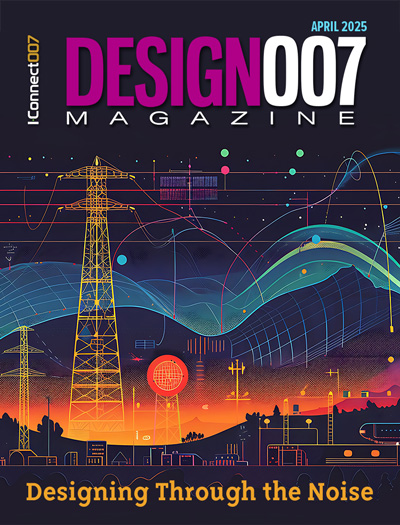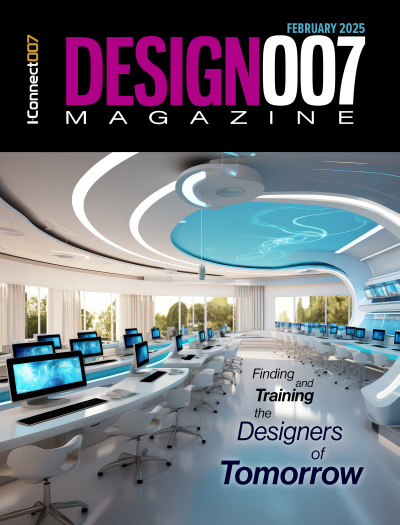-

- News
- Books
Featured Books
- design007 Magazine
Latest Issues
Current Issue
Designing Through the Noise
Our experts discuss the constantly evolving world of RF design, including the many tradeoffs, material considerations, and design tips and techniques that designers and design engineers need to know to succeed in this high-frequency realm.

Learning to Speak ‘Fab’
Our expert contributors clear up many of the miscommunication problems between PCB designers and their fab and assembly stakeholders. As you will see, a little extra planning early in the design cycle can go a long way toward maintaining open lines of communication with the fab and assembly folks.

Training New Designers
Where will we find the next generation of PCB designers and design engineers? Once we locate them, how will we train and educate them? What will PCB designers of the future need to master to deal with tomorrow’s technology?
- Articles
- Columns
Search Console
- Links
- Media kit
||| MENU - design007 Magazine
Back to School With Jonathan Studinka
October 16, 2024 | Andy Shaughnessy, Design007 MagazineEstimated reading time: 3 minutes
At the Anaheim Electronics & Manufacturing Show, I spoke with Jonathan Studinka, a student in John Watson’s PCB design class at Palomar College. In this interview, Jonathan shares his experience, highlighting how John’s class has broadened his understanding of PCBs and sparked his interest in mechatronics. Despite having no prior electronics training, Jonathan says he finds the coursework manageable by taking it step by step.
Andy Shaughnessy: Jonathan, tell us about your PCB design class at Palomar College.
Jonathan Studinka: It’s opened my eyes to many things about PCBs and the world we live in. The device recording this conversation has a PCB in it, so without that PCB, this interview couldn't happen. I wanted to go to the mechanical side at first. But after taking John Watson’s class, I want to look more into mechatronics, combining mechanical and electrical.
Shaughnessy: You mentioned that you have a background in AutoCAD, correct?
Studinka: Yes, I've learned AutoCAD. At my old company, we built water filtration systems for municipalities around San Diego County, and I helped them design a frame for a mixer that would sit in a tank holding up to 10 million gallons.
Shaughnessy: That's pretty cool. What led you to take Watson’s class?
Studinka: Basically, I was just seeing what was out there. I want to do something hands-on, building something from nothing.
Shaughnessy: How far along are you in the coursework?
Studinka: We're six weeks in. It's a very overwhelming thing when you haven't had a background in PCB, not having touched anything about it before. So, I eat the elephant a few bites at a time.
Shaughnessy: Did you have any prior electronics training?
Studinka: No, no electronics training at all. I thought I would go into construction work, but quickly decided that was not a path for me. We had a construction class in my high school. I realized I didn’t want to go down that path.
Shaughnessy: Well, Watson certainly has a jobs pipeline. He says companies ask him for candidate referrals every day.
Studinka: That would be amazing to go from a class right into a job.
Shaughnessy: Since you already have AutoCAD experience, you could be the part-time mechanical guy instead of having to call the mechanical guy.
Studinka: I think it would be cool to wear multiple hats.
Shaughnessy: Would you recommend this class?
Studinka: I would, absolutely. Give it a shot; you don't know until you try, even if you feel like you're in over your head. John takes you through every single step you need to know. I often think that if I do this and this, what will happen to my design? We're just finalizing the schematic, and even in our lab, I was playing around with different pins and this and that, seeing what it would do. I actually was able to fix a few issues just by playing around and seeing what could happen.
Shaughnessy: It is an art. Some people say it's also like a puzzle. Do you like to do puzzles?
Studinka: Yes, it is like a big jigsaw puzzle where the shapes do not always fit together properly, but they go next to each other.
Shaughnessy: That's a good way to look at it. Any final thoughts?
Studinka: No, just get into PCB design, and you can start with this John’s class at Palomar College.
Shaughnessy: Thank you, Jonathan. Glad to see young people coming into PCB design again.
Studinka: Thank you for the opportunity.
Suggested Items
LITEON, Elephantech Deepen Partnership to Further Drive Innovation and End-to-End Sustainability
04/24/2025 | LITEON TechnologyLITEON Technology has signed a second Memorandum of Understanding (MoU) with Elephantech, deepening their strategic partnership in advancing green Printed Circuit Boards (PCB) manufacturing. Announced on Earth Day (April 22), the renewed collaboration highlights their joint commitment to achieving net-zero carbon emissions.
Elementary Mr. Watson: Navigating RF—A Glide Path Approach to Design Success
04/24/2025 | John Watson -- Column: Elementary, Mr. WatsonOn a flight, I can always tell when we begin our descent because that subtle drop in my stomach tells me the altitude has changed. Landing an airplane involves a gradual, precise process called the glide path. It descends at the correct speed and 3-degree angle to touch down smoothly and safely on the runway without bouncing or coming to a sudden stop. Pilots use specialized tools like the Instrument Landing System (ILS) or GPS to stay on the correct path. Lights on the ground, called PAPI lights, help pilots know if they are too high or too low.
Explore Thermal Management Solutions in Latest Podcast Series—New Episode Now Available
04/23/2025 | I-Connect007I-Connect007 is excited to share the latest episode in our new podcast series! In this episode, Ryan returns to discuss practical strategies for managing heat, starting early in the design planning and specification phases. After all, prevention means there’s less to mitigate later.
Real Time with... IPC APEX EXPO 2025: IPC's Growth and Future in India's Manufacturing Sector
04/23/2025 | Real Time with...IPC APEX EXPOGaurab Majumdar, VP for IPC in SE Asia and India, highlights IPC's impressive growth in India, with certification numbers rising significantly. The Indian manufacturing sector is projected to reach a $300 billion market, alongside a $10 billion investment in semiconductors. IPC is addressing industry demands through standards development and a new workforce project aimed at training students for job placements.
Real Time with... IPC APEX EXPO 2025: DuPont Electronics Materials and Innovations
04/23/2025 | Real Time with...IPC APEX EXPODuPont is many things to many markets, but DuPont Electronics Materials is, perhaps, a bit out of the DuPont "norm," developing specialized electronic materials that are particularly focused on challenging areas such as flex circuits, high power PCBs and products that must withstand harsh environments. At IPC APEX EXPO, Marcy LaRont sat down with Shannon Dugan from DuPont Electronics Materials to discuss some big news. They are being spun off into an independent entity with a new CEO having just been announced as the show wrapped.


